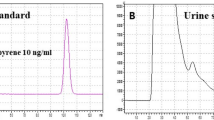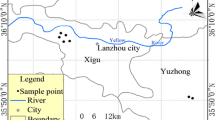Abstract
To study whether the urinary 1-hydroxypyrene (1-OHP) could be the biomarker of atmospheric PAHs, a small-scale pilot study was carried out on the relation of 1-OHP vs PAHs with the traffic policemen in Beijing of smokers and nonsmokers to be subgroups in both the exposure and control groups. Both the PAHs and 1-OHP were analyzed with high performance liquid chromatography (HPLC). The ambient concentrations of PAHs were different at the different sites (the average sum of PAHs (TPAH) were 12.36, 16.27, 18.37 ng/m3 at the suburban residential, police station and high traffic area, respectively.), but considerably lower than the personal-exposure concentrations (the average TPAH were 65.84 and 47.28 ng/m3 for patrol cars and inspection station, respectively). Pyrene was correlated well with BaP and the summed PAHs (TPAH), with the correlation coefficients (R) of 0.79, 0.87 for ambient level and 0.92, 0.96 for personal exposure, respectively. The average of 1-hydroxypyrene of smokers and nonsmokers were 0.39, 0.15 μmol/mol creatinine in control group and 0.57, 0.33 μmol/mol creatinine in exposure group, respectively. The better correlation of pyrene to BaP and TPAH especially for personal exposure samples indicated that the probability of urinary 1-hydroxypyrene, the metabolite of pyrene, to be the biomarker of total PAH. Nonsmokers in the exposure and control groups had indistinguishable levels of 1-OHP, presumably because the ambient levels of pyrene were so similar (the average were 3.25, 3.20 ng/m3 at the police station and high traffic area, respectively.). Smokers in the control group had significantly higher 1-OHP than that of the nonsmokers, but showed indistinguishable differences in the exposure group. These results suggested that urinary 1-OHP could be a biomarker of PAHs only when the level of PAHs was at a relatively higher level. Smoking as an important influencing factor need to be controlled carefully.
Similar content being viewed by others
References
Bentsen, R. K., Halgard, K., Notø, H., Daae, H. L., & Øvrebø, S. (1998). Correlation between urinary 1-hydroxypyrene and ambient air pyrene measured with an inhalable aerosol sampler and a total dust sampler in an electrode paste plant. Science of the Total Environment, 212, 59–67.
Boogaard, P. J., & Van Sittert, N. J. (1995). Urinary 1-hydroxypyrene as biomarker of exposure to polycyclic aromatic hydrocarbons in workers in petrochemical industries: Baseline values and dermal uptake. Science of the Total Environment, 163, 203–209.
Chetiyanukornkul, T., Toriba, A., Kizu, R., & Hayakawa, K. (2004). Urinary 2-hydroxyfluorene and 1-hydroxypyrene levels in smokers and nonsmokers in Japan and Thailand. Polycyclic Aromatic Compounds, 24(4–5), 467–474.
Chu, M., & Chen, C. (1984). Valuation and estimation of potential carcinogenic risks of polynuclear aromatic hydrocarbons. Presented at the Symposium on Polycyclic Aromatic Hydrocarbons in the Workplace. Pacific Rim Risk Conference, Honolulu, Hawaii, 4–7 December.
Dor, F., Dab, W., Empereur-Bissonnet, P., & Zmirou, D. (1999). Validity of biomarkers in environmental health studies: The case of PAHs and benzene. Critical Reviews in Toxicology, 29, 129–168.
Gilbert, N. T., & Viau, C. (1997). Biological monitoring of environmental exposure to PAHs in the vicinity of a Soderberg aluminium plant. Occupational and Environmental Medicine, 54, 619–921.
Hara, K., Hanaoka, T., Yamano, Y., & Itani, T. (1997). Urinary 1-hydroxypyrene levels of garbage collectors with low-level exposure to polycyclic aromatic hydrocarbons. Science of the Total Environment, 199, 159–164.
International Agency for Research on Cancer (IARC) (1986). Tobacco smoking. IARC Monographs on the Evaluation of the Carcinogenic Risk of Chemicals to Human, 38.
International Agency for Research on Cancer (IARC) (1987). IARC Monographs on the Evaluation of the Carcinogenic Risk of Chemicals to Humans, Supplement 7. IARC, Lyons.
Jongeneelen, F. J., Van Leeuwen, F. E., Oosterink, S., Anzion, R. B. M., Van der Loop, F., Bos, R. P., et al. (1990). Ambient and biological monitoring of coke oven workers: Determinants of the internal dose of polycyclic aromatic hydrocarbons. British Journal of Industrial Medicine, 47, 454–461.
Krewski, D., Thorslund, T., & Withey, J. (1989). Carcinogenic risk assessment of complex mixtures. Toxicology and Industrial Health, 5, 851–867.
Larsen, J. C., Larsen, P. B. (1998). Chemical carcinogens. In R. E. Hester & R. M. Harrison (Eds.), Air pollution and health (pp. 33–56). Cambridge, UK: The Royal Society of Chemistry.
Mathuros, R., Chulabhorn, M., Chanthana, T., Sittisak, P. O., Ole, J., Ormrat, K., et al. (2002). Exposure to genotoxins present in ambient air in Bangkok, Thailand – Particle associated polycyclic aromatic hydrocarbons and biomarkers. Science of the Total Environment, 287, 121–132.
McClure, P., & Schoeny, R. (1995). Evaluation of a component-based relative potency approach to cancer risk assessment for exposure to PAH. Paper Presented at Fifteen International Symposium on Polycyclic Aromatic Compounds: Chemistry, Biology and Environmental Impact. Belgirate, Italy, 161.
Merlo, F., Andreassen, A., Weston, A., Pan, C. F., Haugen, A., Valerio, F., et al. (1998). Urinary excretion of 1-hydroxypyrene as a marker for exposure to urban air levels of polycyclic aromatics. Cancer Epidemiology, Biomarkers, and Prevention, 7, 147–155.
Motykiewicz, G., Michalska, J., Pendzich, J., Malusecka, E., Strozyk, M., Kalinowska, E., et al. (1998). A molecular epidemiology study in women from Upper Silesia, Poland. Toxicology Letters, 96–97, 195–202.
Nisbet, C., & LaGoy, P. (1992). Toxic equivalency factors (TEFs) for polycyclic aromatic hydrocarbons (PAHs). Regulatory Toxicology and Pharmacology, 16, 290–300.
Pan, G., Hanaoka, T., Yamano, Y., Hara, K., Ichiba, M., Wang, Y., et al. (1998). A study of multiple biomarkers in coke oven workers-across-sectional study in China. Carcinogenesis, 19, 1963–1968.
Perico, A., Bavazzano, P., Gottardi, M., Lanciotti, E., & Boddi, V. (2001). Assessment of exposure to polycyclic aromatic hydrocarbons in police in Florence, Italy, through personal air sampling and biological monitoring of the urinary metabolite 1-hydroxypyrene. Archives of Environmental Health, 56(6), 506–512.
US EPA (1998). Polynuclear Aromatic Hydrocarbons by HPLC, Method 5506. US Environmental Protection Agency (EPA).
Sorensen, M., Autrup, H., Hertel, O., Wallin, H., Knudsen, L. E., & Loft, S. (2003). Personal exposure to PM2.5 in an urban environment and biomarkers of genotoxicity. Cancer Epidemiology, Biomarkers, and Prevention, 12, 191–196.
Thorslund, T., & Farrer, D. (1991). Development of relative potency estimated for PAHs and hydrocarbon combustion product fractions compared to benzo(a)pyrene and their use in carcinogenic risk assessments. Washington, District of Columbia: US Environmental Protection Agency (EPA).
Tsai, P. J., Shieh, H. Y., Lee, W. J., & Lai, S. O. (2001). Health-risk assessment for workers exposed to polycyclic aromatic hydrocarbons (PAHs) in carbon black manufacturing industry. Science of the Total Environment, 278, 137–150.
Van Delft, J. H. M., Steenwinkel, M. J. S. T., Van Asten, J. G., Van Es, J., Kraak, A., & Baan, R. (1997). Monitoring of occupational exposure to polycyclic aromatic hydrocarbons in a carbon-electrode manufacturing plant. Annals of Occupational Hygiene,42 (2), 105–114.
Van Schooten, F. J., Jongenleen, F. J., & Hillebrand, M. J. (1995). Pocycylic aromatic hydrocarbon-DNA adducts in white blood cell DNA and 1-hydroxypyrene in the urine from aluminum workers: Relation with job category and synergistic effect of smoking. Cancer Epidemiology, Biomarkers, and Prevention, 4, 69–77.
Viau, C., Vyskocil, A., & Martel, L. (1995). Background urinary 1-hydroxypyrene levels in non-occupationally exposed individuals in the Province of Quebec, Canada, and comparison with its excretion in workers exposed to PAH mixtures. Science of the Total Environment, 163(1–3), 191–194.
WS/T97 (1996). Spectrophotometry analytical method for urinary creatinine. (In Chinese).
Zhao, Z. H., Quan, W. Y., & Tian, D. H. (1990). Urinary 1-hydroxypyrene as an indicator of human exposure to ambient polycyclic aromatic hydrocarbons in a coal-burning environment. Science of the Total Environment, 92, 145–154.
Author information
Authors and Affiliations
Corresponding author
Rights and permissions
About this article
Cite this article
Zhang, W., Xu, D., Zhuang, G. et al. A Pilot Study on Using Urinary 1-Hydroxypyrene Biomarker for Exposure to PAHs in Beijing. Environ Monit Assess 131, 387–394 (2007). https://doi.org/10.1007/s10661-006-9484-2
Received:
Accepted:
Published:
Issue Date:
DOI: https://doi.org/10.1007/s10661-006-9484-2




